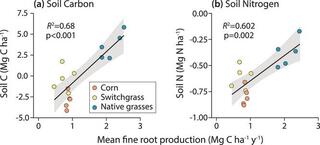Long-term changes in soil carbon and nitrogen fractions in switchgrass, native grasses, and no-till corn bioenergy production system
S. Perry et al. "Long-term changes in soil carbon and nitrogen fractions in switchgrass, native grasses, and no-till corn bioenergy production systems" Soil Science Society of America Journal 87:1365 (2023) [DOI: 10.1002/saj2.20575]
Cellulosic bioenergy is a primary land-based climate mitigation strategy, with soil carbon (C) storage and nitrogen (N) conservation as important mitigation elements. Here, we present 13 years of soil C and N change under three cellulosic cropping systems: monoculture switchgrass (Panicum virgatum L.), a five native grasses polyculture, and no-till corn (Zea mays L.). Soil C and N fractions were measured four times over 12 years. Bulk soil C in the 0–25 cm depth at the end of the study period ranged from 28.4 (± 1.4 se) Mg C ha−1 in no-till corn, to 30.8 (± 1.4) Mg C ha−1 in switchgrass, and to 34.8 (± 1.4) Mg C ha−1 in native grasses. Mineral-associated organic matter (MAOM) ranged from 60% to 90% and particulate organic matter (POM) from 10% to 40% of total soil C. Over 12 years, total C as well as both C fractions persisted under no-till corn and switchgrass and increased under native grasses. In contrast, POM N stocks decreased 33% to 45% across systems, whereas MAOM N decreased only in no-till corn and by less than 13%. Declining POM N stocks likely reflect pre-establishment land use, which included alfalfa and manure in earlier rotations. Root production and large soil aggregate formation explained 69% (p < 0.001) and 36% (p = 0.024) of total soil C change, respectively, and 60% (p = 0.020) and 41% (p = 0.023) of soil N change, demonstrating the importance of belowground productivity and soil aggregates for producing and protecting soil C and conserving soil N. Differences between switchgrass and native grasses also indicate a dependence on plant diversity. Soil C and N benefits of bioenergy crops depend strongly on root productivity and pre-establishment land use.
Data in this contribution are available at Dryad https://datadryad.org/stash/dataset/doi:10.5061/dryad.547d7wmf3
